Abstract
Background
Limbal ring (also known as ‘circle’) contact lenses are becoming increasingly popular, especially in Asian markets because of their eye-enhancing effects. The pigment particles that give the eye-enhancing effects of these lenses can be found on the front or back surface of the contact lens or ‘enclosed’ within the lens matrix. The purpose of this research was to evaluate the pigment location and surface roughness of seven types of ‘circle’ contact lenses.
Methods
Scanning electron microscopic (SEM) analysis was performed using a variable pressure Hitachi S3400N instrument to discern the placement of lens pigments. Atomic force microscopy (Dimension Icon AFM from Bruker Nano) was used to determine the surface roughness of the pigmented regions of the contact lenses. Atomic force microscopic analysis was performed in fluid phase under contact mode using a Sharp Nitride Lever probe (SNL-10) with a spring constant of 0.06 N/m. Root mean square (RMS) roughness values were analysed using a generalised linear mixed model with a log-normal distribution. Least square means and their corresponding 95% confidence intervals were estimated for each brand, location and pigment combination.
Results
SEM cross-sectional images at 500× and 2,000× magnification showed pigment on the surface of six of the seven lens types tested. The mean depth of pigment for 1-DAY ACUVUE DEFINE (1DAD) lenses was 8.1 μm below the surface of the lens, while the remaining lens types tested had pigment particles on the front or back surface. Results of the atomic force microscopic analysis indicated that 1DAD lenses had significantly lower root mean square roughness values in the pigmented area of the lens than the other lens types tested.
Conclusions
SEM and AFM analysis revealed pigment on the surface of the lens for all types tested with the exception of 1DAD. Further research is required to determine if the difference in pigment location influences on-eye performance.
Keywords: atomic force microscopy, daily disposable, limbal ring contact lenses, pigment location scanning electron microscopy, surface roughness
Since soft contact lenses were first introduced, they have had to maintain a delicate balance of correcting visual acuity without disrupting ocular health. This task has been approached by the development of increasingly compatible lens materials and sophisticated lens designs. In addition to correcting visual acuity, contact lenses can also be used to change the appearance of the eye. This was originally approached by changing and/or enhancing the appearance of the iris colour with so-called ‘cosmetic lenses’, which sometimes resulted in a dramatic effect.
The literature has reported conflicting findings when it comes to the clinical response while wearing cosmetic contact lenses. Generally, reported issues associated with cosmetic contact lens wear occur as a result of poor user compliance. Schanzer and colleagues1 reported in 1989 on the development of irregular corneal astigmatism, while wearing tinted soft contact lenses over a long period of time. In 1997, Bucci and colleagues2 reported on ‘the annular tinted contact lens syndrome’, which showed reversible corneal irregularities due to the use of tinted contact lenses. Young, Young and Lakkis3 recently published a summary of case reports involving ocular complications with contact lenses obtained from unregulated supplies, the majority of which involved cosmetic contact lenses. Steinemann and colleagues4 and Singh and colleagues5 also published an observational case series of complications associated with cosmetic contact lenses that were obtained from unregulated sources. On the other end of the spectrum, Fisher and Comstock6 reported findings on five blue-tinted opaque contact lenses, which were found not to differ from each other and had a limited ocular impact with daily wear in a controlled clinical trial.
As opposed to the traditional ‘opaque’ cosmetic contact lenses, which change the appearance of the iris colour, there has recently been a surge of ‘limbal ring’ contact lenses in the marketplace. The dark ring near the edge of the cornea where the iris meets the sclera can be referred to as the ‘limbal ring’ of the eye. The width and opacity of this area is influenced by iris pigmentation which may become less prominent with age and with conditions such as pterygium and arcus senilus, which suggests a prominent limbal ring may be seen as a sign of youth. There is some evidence in the literature that the limbal ring area influences the attractiveness of ones’ face and the effect has been reproduced by artists including Botticelli, to create an ‘enhanced’ look.7,8
Limbal ring contact lenses enlarge the appearance of the eye by providing additional definition between the iris and the sclera. This additional definition is achieved by adding pigmentation in a ring pattern to a contact lens. Limbal ring contact lenses are becoming increasingly popular in the Asian marketplace and now represent a US$400 million business in Asia (Japan, three cities in China, Taiwan, Singapore, South Korea, Malaysia; retail data only - no internet sales, unpublished data).
Pigments used in contact lenses need to be non-toxic and safe for on-eye wear; however, pigments approved for use in medical devices vary by country. The US FDA has a long-standing list of approved colour additives for use with medical devices, including contact lenses. Included in this list are pigments such as chromium oxide greens, chromium-cobalt-aluminum oxide and iron oxides.9
In addition to being non-toxic to the eye, the location of the pigment is also important. The pigment used in the limbal ring contact lenses can be located either on the surface of the lens (front or back) or enclosed within the lens matrix. Pigments located on the lens surface are directly in contact with the ocular surface—either the cornea (if the pigmented is located on the back surface of the lens) or the palpebral conjunctiva (if the pigment is located on the front surface). The roughness of the pigments located on either the front or back surface of the limbal ring contact lens have the potential to impact ocular physiology and product performance. Steffen and Barr10 found a statistically significant difference in comfort preference between an opaque cosmetic lens that was observed to have raised areas on the lens surface, where the colorant was located (Durasoft 3 colours) compared to the same lens material without pigment (Durasoft 3 clear). They concluded that the roughness of these raised areas or a difference in wettability between the clear and coloured areas of the lens to be the possible cause for the discomfort. Contact lens surface roughness is a factor in bacterial adherence with non-pigmented soft contact lenses.11 This idea is gaining more attention; for example, a recent DaVinci award lecture at the annual British Contact Lens Association meeting reported on the microbial adherence to limbal ring contact lenses that were found to have pigment on the lens surface, as opposed to those that had pigment enclosed within the lens matrix (BCLA 2013, unpublished data).
The scanning electron microscope (SEM) has a large depth of field and high resolution, which allows more of a specimen to be in focus at one time and can be magnified at much higher levels than light microscopy. Because the SEM uses electromagnets rather than optical lenses, the degree of magnification can be well-controlled. Once the beam hits the sample, electrons and X-rays are ejected from the sample surface. Detectors collect these backscattered electrons, X-rays and secondary electrons and convert them into a signal that is sent to a computer for further analysis.12
Nanoscale roughness of a surface can be measured by atomic force microscopy (AFM), which is a very high-resolution type of scanning probe microscopy that can image both hard and soft material surfaces at the nanoscale level.13 AFM can be operated in a number of modes depending on the application. In general, imaging modes include dynamic (or non-contact) and static (contact) modes. When tested in dynamic mode, the AFM tip is not in full contact with the sample surface but resonates at a certain frequency. In static mode, the AFM tip makes soft physical contact with the sample surface. As the tip scans across the sample surface at a constant contact force, the cantilever bends up or down depending on the roughness of the surface. In this study, all AFM measurements were performed under contact mode to scan the contact lens surfaces. The results are reported in two measures which can provide valuable information when assessing the contact lens surface, namely, root mean square (RMS) ‘roughness’, which assesses the average roughness of a given area and ‘peak-to-peak’, which is the difference in height from the peak-to-valley of a given area. The lower the value of RMS roughness, the smoother the surface of the material. The tighter (and lower) the range of peak-to-peak values, the flatter the topography of the material surface.
There are previous reports in the literature of measuring the surface of soft contact lenses with AFM.14–20 González-Méijome and colleagues19 analysed the surface roughness of both worn and unworn silicone hydrogel lenses, finding a RMS range of four to 15 nm for unworn samples and seven to 18 nm for the worn samples.
When measuring pigmented contact lenses, the region specific to the limbal ring location can be analysed separately from the non-pigmented areas using atomic force microscopy. An increase in surface roughness of the pigmented area compared to the non-pigmented region of the lens would indicate that the pigments are located on or close to the surface. Both the front and back surfaces of the contact lenses can also be measured by AFM.
In this study, for the first time in the peer-reviewed literature, the location of the pigment and its effect on the lens surface roughness were evaluated by using SEM and AFM on seven different daily disposable limbal ring lens brands. Cross-sections of limbal ring contact lenses were analysed using a SEM to determine the location of pigments with respect to the front or back surfaces. Fluid phase AFM was used to assess the effect of pigments on the roughness of the front or back surfaces of the lenses studied. The roughness values of the contact lenses that had pigment enclosed within the lens matrix were statistically compared to those that had pigment particles on the lens surface.
Methods
SEM image analysis
The lens samples were removed from the manufacturer packaging, placed front (convex) surface down on a clean glass slide, cross-sectioned with a razor blade and mounted onto a lens holder for SEM imaging with a Hitachi model S-3400N SEM at an ISO 17025 accredited laboratory. The images were recorded at an acceleration voltage of 10 kV under variable pressure (30–50 mPa) operating mode and using a back-scattered electron detection. One 500× magnification image of each cross-section was obtained to show the entire width of the sample and the general location of the pigment particles. A 500× magnification (and in some cases a 2,000× magnification) image was taken in a top-down or bottom-up view. To measure the depth of the pigment particles, three 2,000× magnification images of each specimen were obtained. For analysis, the uncertainty of dimensional SEM measurements is about ±10 per cent (providing an estimated level of confidence of 95%).21
Three to 12 lenses per lens brand were tested for each of the following seven lens types: CAMAX COLOR (CC); 1-DAY ACUVUE® DEFINE™ (1DAD); One-Day Delight Max 2 (DM2); Seed Eye Coffret UV (ECO); FreshLook® One-Day Color (FLC); Naturelle™ Daily Disposable (NAT); and TICON Cosmetic Daily Ring Black (TC) contact lenses (Table 1).
Table 1.
Lens brands, manufacturers, region available, variants and powers tested listed in alphabetical order
| Contact lens brand | Manufacturer | Region available | Variant(s) | Lens powers tested |
|---|---|---|---|---|
| CAMAX COLOR Daily Disposable Contact Lens (CC) | CAMAX | Taiwan | Brown | -1.00 D, -3.00 D, -6.00 D |
| 1-DAY ACUVUE® DEFINE™ (1DAD) |
Johnson & Johnson Vision Care, Inc. | Asia Pacific Japan |
ACCENT VIVID |
-1.00 D, -3.00 D, -9.00 D |
| ONE-DAY Delight MAX 2 (DM2) |
Woods HK Ltd. | Hong Kong Macau |
Hazel | -1.00 D, -3.00 D, -6.00 D |
| Eye Coffret 1 day UV (ECO) |
SEED | Japan | Base make | 0.00 D, -1.00 D |
| FreshLook® One-Day Color Contact Lens (FLC) |
Alcon Vision Care | Asia Pacific | Grey (daily) | -1.00 D, -3.00 D, -6.00 D |
| Naturelle™ Daily Disposable (NAT) |
Bausch + Lomb | Korea | Naturelle | 0.00 D, -3.00 D, -6.00 D |
| TICON Cosmetic Daily—Ring Black (TC) |
TICON | Taiwan | Black | -1.00 D, -3.00 D, -6.00 D |
AFM image analysis
Atomic force microscopic images were acquired for the seven lens types in fluid phase with a Dimension Icon AFM from Bruker Nano under contact mode using Sharp Nitride Lever probes (SNL-10) with a spring constant of 0.06 Newton per metre. The area of lens under AFM imaging and the AFM tip were kept hydrated with a droplet of standard lens packing solution. Within each lens brand, multiple lenses from each power tested were selected for measurement. RMS roughness and peak-to-peak values were obtained by analysing three 20 μm × 20 μm regions (front curve, back curve, pigmented and non-pigmented) of these images. Four replicates of RMS and peak-to-peak measurements were selected for each area within each lens at a given location or pigment status. Thus, a total of 12 measurements were recorded for each lens at a given location or pigment area.
Data from RMS and peak-to-peak responses were determined to be log-normally distributed. These responses were analysed separately using a generalised linear mixed model with a log-normal distribution. Location (front versus back curve), pigment area (pigmented versus non-pigmented) and lens brand were included as fixed effects. All two-way and three-way interactions between location, pigment and brand were also included as fixed effects. Lens number within each brand was included as a random effect. Replicates nested within lens number and area number were modelled as random effects within each brand. Least squares mean values and their corresponding 95% confidence intervals were estimated for each brand, location and pigment combination.
Results from the SEM image analyses were used to determine the appropriate pair-wise comparisons between lens brands. Pair-wise comparisons were made for each lens brand for pigment versus no pigment on the lens surfaces. In this study, the SEM analysis indicated only one comparator without pigment located on the lens surface. Thus, all comparisons were made against this lens.
Since the analysis was completed on the log-scale, the AFM estimates and their interval bounds were exponentiated to provide model-based estimates on the original, untransformed scale. Since multiple comparisons were considered, a simulation adjustment for alpha was completed to control the ‘type I error’ rate at 5%. Significance is noted for simulation-adjusted p-values of less than 0.05.
Results
SEM
CC, DM2, ECO and TC lenses were found to have pigments on the back surface (concave side) of the contact lens, while the pigments for NAT and FLC were found on the front surface (convex side) of the contact lens. The pigment particles were visible on the lens surface in top-down/bottom-up views, as well as in cross-sectional view appearing to extend from an average depth of 1.3 μm to 3.5 μm up to and including the lens surface for a depth range of 0.0 to 4.3μm. The pigment particles for the 1DAD were buried below the front surface of the lens at an average depth of 8.1 μm with a range of 7.6 to 9.1 μm (Table 2).
Table 2.
Depth range for pigments from the lens surface when imaged by scanning electron microscope (SEM) for each lens type
| Pigment location | Lens type | Depth range (from lens surface) (μm) |
|---|---|---|
| Below the front surface | 1DAD | 7.6–9.1 |
| Lens back surface | CC | 0.0–4.1 |
| DM2 | 0.0–3.4 | |
| ECO | 0.0–3.7 | |
| TC | 0.0–3.2 | |
| Lens front surface | FLC | 0.0–4.3 |
| NAT | 0.0–2.3 |
1DAD: 1-DAY ACUVUE DEFINE, CC: Camax Color, DM2: One-Day Delight Max 2, ECO: Eye Coffret, TC: Ticon Cosmetic Ring Black, FLC: Freshlook One-Day Color, NAT: Naturelle Daily Disposable
Figures 1 7 show the cross-sectional depths at 2,000× magnification for each of the lens types. Each representative image includes a micron ‘legend’ to orient the viewer. The images show no pigment particles on the top of the 1DAD lenses, while a particle layer is on the surface of all other lenses tested. These results were used to determine the statistical comparisons to be completed for the AFM findings (surface pigmented lenses versus non-surface pigmented lenses).
Figure 1.
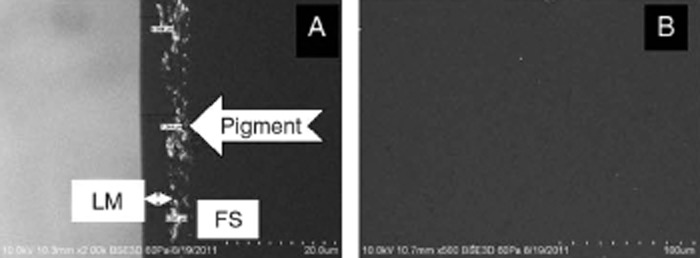
Scanning electron microscopic (SEM) images of 1DAD. Cross-sectional view at 2,000× magnification showing pigment enclosed within the lens matrix (LM) below the front lens surface (A) and an image of the lens front surface at 500× magnification showing no pigment particles (B). FS: front surface. 1DAD: 1-DAY ACUVUE DEFINE.
Figure 7.
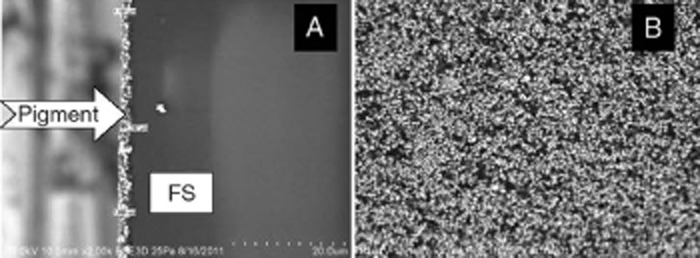
Scanning electron microscopic (SEM) images of NAT. Cross-sectional view at 2,000× magnification showing pigment on the front surface (FS) of the lens (A) and an image of the lens front surface at 2,000× magnification showing visible pigment particles (B). NAT: Naturelle Daily Disposable.
Figure 2.
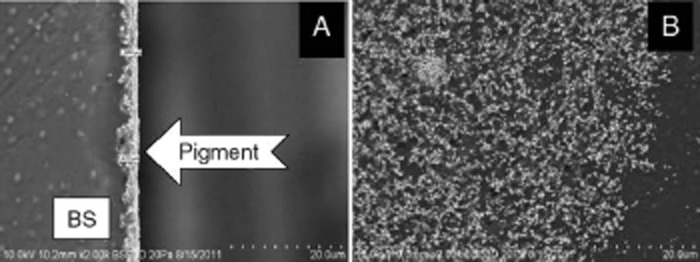
Scanning electron microscopic (SEM) images of CC. Cross-sectional view at 2,000× magnification showing pigment on the back surface (BS) of the lens (A) and an image of the lens back surface at 2,000× magnification showing visible pigment particles (B). CC: Camax Color.
Figure 3.
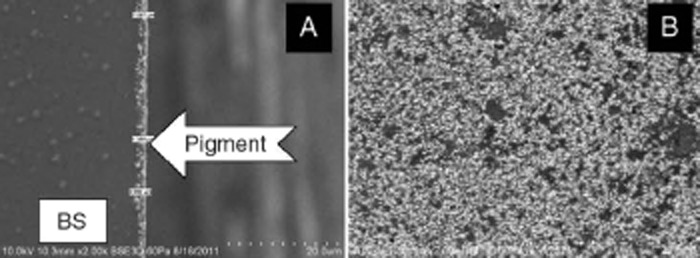
Scanning electron microscopic (SEM) images of DM2. Cross-sectional view at 2,000× magnification showing pigment on the back surface (BS) of the lens (A) and an image of the lens back surface at 2,000× magnification showing visible pigment particles (B). DM2: One-Day Delight Max 2.
Figure 4.
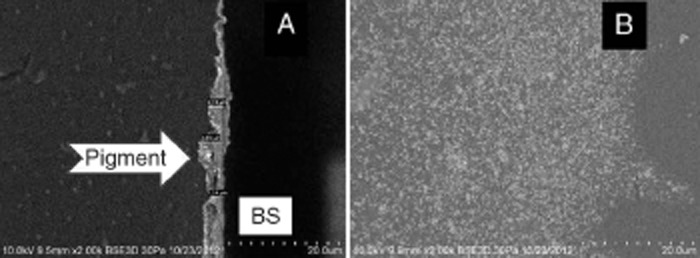
Scanning electron microscopic (SEM) images of ECO. Cross-sectional view at 2,000× magnification showing pigment on the back surface (BS) of the lens (A) and an image of the lens back surface at 2,000× magnification showing visible pigment particles (B). ECO: Eye Coffret.
Figure 5.

Scanning electron microscopic (SEM) images of TC. Cross-sectional view at 2,000× magnification showing pigment on the back surface (BS) of the lens (A) and an image of the lens back surface at 2,000× magnification showing visible pigment particles (B). TCL: Ticon Cosmetic Ring Black.
Figure 6.
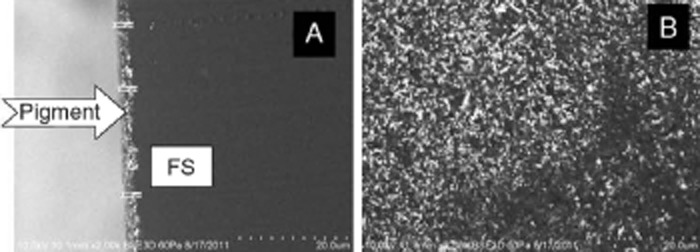
Scanning electron microscopic (SEM) images of FLC. Cross-sectional view at 2,000× magnification showing pigment on the front surface (FS) of the lens (A) and an image of the lens front surface at 2,000× magnification showing visible pigment particles (B). FLC: Freshlook One-Day Color.
AFM
The results of the AFM analysis indicated that 1DAD lenses had a statistically significantly lower RMS value in the pigmented area than CC, DM2, ECO, TC, FLC and NAT contact lenses. Table 3 displays the measures for each lens type by curve/print aspect combinations. Table 4 and Figure 8 summarise the statistical findings and graphically show the mean roughness values for each lens type in the different lens areas. Figure 9 shows representative AFM images of the pigmented areas for each lens type.
Table 3.
Atomic force microscopic average and range ± SD (and range) for root mean square (RMS) and ‘peak-to-peak’ values for the front and back surfaces, pigmented and non-pigmented areas
| Pigment location | Lens type | Front surface/pigmented | Back surface/pigmented | Front surface/non-pigmented | Back surface/non-pigmented | ||||
|---|---|---|---|---|---|---|---|---|---|
| RMS (nm) | Peak-to-peak (nm) | RMS (nm) | Peak-to-peak (nm) | RMS (nm) | Peak-to-peak (nm) | RMS (nm) | Peak-to-peak (nm) | ||
| Below front surface | 1DAD | 6 ± 2 | 79 ± 30 | 7 ± 2 | 84 ± 33 | 5 ± 1 | 62 ± 24 | 7 ± 1 | 74 ± 26 |
| [4–14] | [62–107] | [3–18] | [58–116] | [3–8] | [45–91] | [4–10] | [45–96] | ||
| Lens back surface | CC | 39 ± 11 | 460 ± 152 | 43 ± 34 | 438 ± 243 | 6 ± 3 | 65 ± 45 | 11 ± 8 | 122 ± 65 |
| [22–96] | [188–903] | [16–188] | [158–1990] | [3–18] | [28–383] | [4–58] | [38–503] | ||
| DM2 | 27 ± 7 | 284 ± 91 | 35 ± 18 | 388 ± 209 | 5 ± 2 | 59 ± 43 | 11 ± 5 | 144 ± 60 | |
| [17–51] | [141–579] | [16–101] | [148–958] | [3–12] | [25–261] | [3–37] | [42–372] | ||
| ECO | 39 ± 19 | 344 ± 102 | 61 ± 23 | 636 ± 258 | 6 ± 2 | 113 ± 52 | 6 ± 3 | 102 ± 48 | |
| [12–85] | [94–560] | [19–146] | [228–1396] | [3–14] | [29–318] | [2–17] | [27–384] | ||
| TC | 33 ± 13 | 394 ± 130 | 36 ± 24 | 335 ± 148 | 5 ± 2 | 65 ± 39 | 8 ± 4 | 130 ± 69 | |
| [15–92] | [149–934] | [13–168] | [118–815] | [3–14] | [27–301] | [4–23] | [34–368] | ||
| Lens front surface | FLC | 40 ± 23 | 350 ± 112 | 4 ± 2 | 75 ± 38 | 4 ± 3 | 73 ± 28 | 3 ± 2 | 48 ± 24 |
| [15–129] | [143–930] | [2–12] | [26–211] | [1–12] | [17–159] | [1–8] | [17–183] | ||
| NAT | 39 ± 16 | 297 ± 186 | 6 ± 2 | 76 ± 36 | 11 ± 3 | 103 ± 22 | 6 ± 2 | 79 ± 33 | |
| [8–104] | [104–600] | [4–11] | [32–210] | [7–20] | [64–208] | [4–15] | [45–306] | ||
1DAD: 1-DAY ACUVUE DEFINE, CC: Camax Color, DM2: One-Day Delight Max 2, ECO: Eye Coffret, TC: Ticon Cosmetic Ring Black, FLC: Freshlook One-Day Color, NAT: Naturelle Daily Disposable.
Boldface type indicates location of the pigment.
Table 4.
Statistical analysis of atomic force microscopy root mean square (RMS) values for lenses found to have surface pigment versus the lens with pigments enclosed within the lens matrix
| Pigment location | Lens type | Least squares mean difference estimate (log scale) | Standard error (log scale) | Simulation-adjusted p-value* |
|---|---|---|---|---|
| Lens back surface | CC | 1.6412 | 0.08701 | <0.001 |
| DM2 | 1.5378 | 0.1100 | <0.001 | |
| ECO | 2.1163 | 0.1012 | <0.001 | |
| TC | 1.5226 | 0.08055 | <0.001 | |
| Lens front surface | FLC | 1.7084 | 0.1032 | <0.001 |
| NAT | 1.7412 | 0.05961 | <0.001 |
1DAD: 1-DAY ACUVUE DEFINE, CC: Camax Color, DM2: One-Day Delight Max 2, ECO: Eye Coffret, TC: Ticon Cosmetic Ring Black, FLC: Freshlook One-Day Color, NAT: Naturelle Daily Disposable.
* p-values are all versus 1DAD
Figure 8.
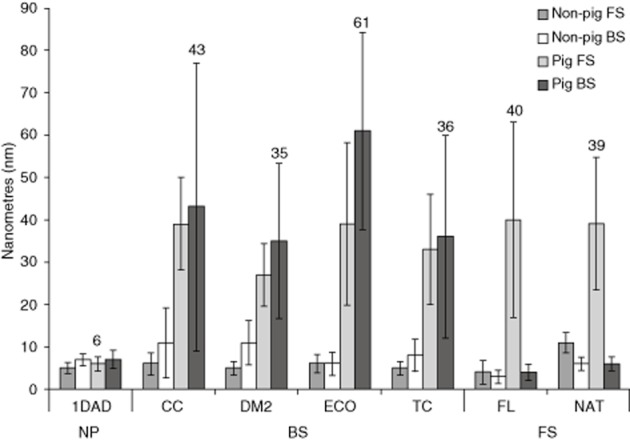
Average root mean square (RMS) roughness values determined by atomic force microscopy on the non-pigmented area of the front lens surface (non-pig FS) and back lens surface (non-pig BS) as well as the pigmented area of the front (pig FS) and back lens surfaces (pig BS). Pigment location was determined by scanning electron microscopy (NP: no pigment on the lens surface, BS: back surface pigment, FS: front surface pigment). 1DAD: 1-DAY ACUVUE DEFINE, CC: Camax Color, DM2: One-Day Delight Max 2, ECO: Eye Coffret, TC: Ticon Cosmetic Ring Black, FLC: Freshlook One-Day Color, NAT: Naturelle Daily Disposable.
Figure 9.
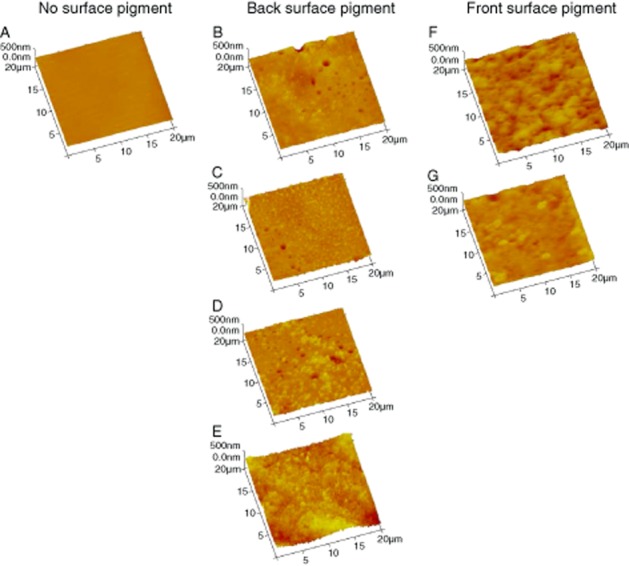
Atomic force microscopic images of pigmented areas for 1DAD (A), TC (B), CC (C), DM2 (D), ECO (E), NAT (F), and FLC (G). 1DAD: 1-DAY ACUVUE DEFINE, CC: Camax Color, DM2: One-Day Delight Max 2, ECO: Eye Coffret, TC: Ticon Cosmetic Ring Black, FLC: Freshlook One-Day Color, NAT: Naturelle Daily Disposable.
Additionally, 1DAD lenses had roughness values that were more consistent between the pigmented and non-pigmented areas compared to the other lens types measured. RMS roughness values for 1DAD ranged from three to 18 nm, while RMS values for the other lens tested ranged from two to 188 nm.
Discussion
The SEM imaging results showed, both at the lens surface and throughout the depth of the lens, that the limbal ring pigment used for 1DAD was enclosed within the lens matrix, and therefore would not be in direct contact with the ocular surface when worn. For the other lens types evaluated, each lens was found to have pigment at the surface level, some on the front surface and some on the back. The differences in pigment location are likely to be due to differences in the manufacturing processes.
The testing methodology used for this analysis with AFM measured the samples from similar locations, which resulted in a consistent comparison among the lenses tested. AFM analysis showed 1DAD lenses had lower roughness values (that is, a smoother surface) than the other limbal ring lenses tested within the pigmented area of the lens. Additionally, 1DAD had a more consistent roughness profile regardless of the curvature or pigmented side than any of the other limbal ring contact lenses tested. Differences in surface roughness between the pigmented and non-pigmented areas are likely the result of pigment location (due to the fact that this can be visualised at a low magnification) but surface roughness of the non-pigmented areas can be related to manufacturing methods as well as material properties of the bulk material.22,23 Although there are no thresholds of acceptable or non-acceptable RMS roughness for contact lenses, values in the range of one to 11 nm for cast-moulded contact lenses can be considered normal and smooth.
Biomaterials research evaluating the effect of surface roughness and surface wettability on bacterial attachment to glass has suggested even nanoscale levels of roughness can impact bacterial adherence. Mitik-Dineva and colleagues23 found changes in surface wettability had no impact on bacterial attachment but the roughness of the material was found to play a role. Although Mitik-Dineva and colleagues conducted their research using glass plates, later work published by Giraldez and Yebra-Pimentel11 would suggest surface roughness is also a factor for bacterial adhesion with contact lenses. Additional research is needed to determine to what effect pigment on the surface of a contact lens may have on product performance, including the adhesion of bacteria and the levels of bacteria that may be considered to be clinically relevant.
It is important for eye-care providers to understand potential differences between limbal ring contact lenses, when determining what to prescribe for their patients, beyond the consumer-desired eye-enhancement effects. With the growing market and consumer interest in limbal ring lenses, pigment location and surface roughness are valid considerations. Although there has been some recent research reporting potential clinical implications with limbal ring contact lenses that have pigment on the surface of the lens, the clinical effects of pigment location of these lenses needs to be evaluated further.
Acknowledgments
The authors are currently employed by Johnson & Johnson Vision Care, Inc., the manufacturer of 1-DAY ACUVUE® DEFINE™ Brand Contact Lenses.
references
- Schanzer MC, Mehta RS, Arnold TP, Zuckerbrod SL, Koch D. Irregular astigmatism induced by annular tinted contact lenses. CLAO J. 1989;15:207–211. [PubMed] [Google Scholar]
- Bucci F, Evans R, Moody K, Tanner J, Capozza R, Klyce S. The annular tinted contact lens syndrome: corneal topographic analysis of ring-shaped irregular astigmatism caused by annular tinted contact lenses. CLAO J. 1997;23:161–167. [PubMed] [Google Scholar]
- Young G, Young AGH, Lakkis C. Review of complications associated with contact lenses from unregulated sources of supply. Eye Contact Lens. 2014;40:58–64. doi: 10.1097/ICL.0b013e3182a70ef7. [DOI] [PubMed] [Google Scholar]
- Steinemann TL, Pinninti U, Szczotka LB, Eiferman RA, Price FW., Jr Ocular complications associated with the use of cosmetic contact lenses from unlicensed vendors. Eye Contact Lens. 2003;29:196–200. doi: 10.1097/00140068-200310000-00002. [DOI] [PubMed] [Google Scholar]
- Singh S, Satani D, Patel A, Vhankade R. Colored cosmetic contact lenses: an unsafe trend in the younger generation. Cornea. 2012;31:777–779. doi: 10.1097/ICO.0b013e31823cbe9c. [DOI] [PubMed] [Google Scholar]
- Fisher K, Comstock T. Clinical comparison of opaque tint soft contact lenses. ICLC. 1996;23:128–137. [Google Scholar]
- Peshek D, Semmaknejad N, Hoffman D, Foley P. Preliminary evidence that the limbal ring influences facial attractiveness. Evol Psychol. 2011;9:137–146. [PubMed] [Google Scholar]
- Shyu BP, Wyatt HJ. Appearance of the human eye: Optical contributions to the ‘limbal ring. Optom Vis Sci. 2009;86:1069–1077. doi: 10.1097/OPX.0b013e3181b4f010. [DOI] [PubMed] [Google Scholar]
- Color Additives Approved for Use in Medical Devices. Title 21 of the Code of Federal Regulations Parts 73 and 74.
- Steffen RB, Barr J. Clear versus opaque soft contact lenses: initial comfort comparison. ICLC. 1993;20:183–186. [Google Scholar]
- Giraldez MJ, Yebra-Pimentel E. Hydrogel Contact Lens Surface Roughness and Bacterial Adhesion. In: Adio A, editor. Ocular Diseases. InTech; 2012. pp. 95–120. 10.5772/48436. Available from: http://www.intechopen.com/books/ocular-diseases/hydrogel-contact-lenses-surface-roughness-and-bacterial-adhesion . [Google Scholar]
- Goldstein J, Newbury D, Joy D, Lyman C, Echlin P, Lifshin E, Sawyer L. Scanning Electron Microscopy and X-ray Microanalysis. 3rd ed. New York: Springer; 2003. et al. [Google Scholar]
- Baro AM, Reifenberger RG. Atomic Force Microscopy in Liquid: Biological Applications. Germany: Wiley-VCH; 2012. [Google Scholar]
- Baguet J, Sommer F, Claudon-Eyl V, Duc TM. Characterization of lachrymal component accumulation on worn soft contact lens surfaces by atomic force microscopy. Biomaterials. 1995;16:3–9. doi: 10.1016/0142-9612(95)91089-h. [DOI] [PubMed] [Google Scholar]
- Bruinsma GM, Rustema-Abbing M, de Vries J, Busscher HJ, van der Linden ML, Hooymans JM, van der Mei HC. Multiple surface properties of worn RGP lenses and adhesion of Pseudomonas aeruginosa. Biomaterials. 2003;24:1663–1670. doi: 10.1016/s0142-9612(02)00542-2. [DOI] [PubMed] [Google Scholar]
- Lira M, Santos L, Azeredo J, Yebra-Pimentel E, Oliveira ME. Comparative study of silicone-hydrogel contact lenses surfaces before and after wear using atomic force microscopy. J Biomed Mater Res B Appl. Biomater. 2008;85:361–367. doi: 10.1002/jbm.b.30954. [DOI] [PubMed] [Google Scholar]
- Guryca V, Hobzova R, Pradny M, Sirc J, Michalek J. Surface morphology of contact lenses probed with microscopy techniques. Cont Lens Anterior Eye. 2007;30:215–222. doi: 10.1016/j.clae.2007.02.010. [DOI] [PubMed] [Google Scholar]
- González-Méijome JM, Lopez-Alemany A, Almeida JB, Parafita MA, Refojo MF. Microscopic observation of unworn siloxane-hydrogel soft contact lenses by atomic force microscopy. J Biomed Mater Res B Appl Biomater. 2006;76:412–418. doi: 10.1002/jbm.b.30387. [DOI] [PubMed] [Google Scholar]
- González-Méijome JM, Lopez-Alemany A, Almeida JB, Parafita MA. Surface AFM microscopy of unworn and worn samples of silicone hydrogel contact lenses. J Biomed Mater Res B Appl Biomater. 2009;88:75–82. doi: 10.1002/jbm.b.31153. [DOI] [PubMed] [Google Scholar]
- Teichroeb JH, Forrest JA, Ngai V, Martin JW, Jones L, Medley J. Imaging protein deposits on contact lens materials. Optom Vis Sci. 2008;85:1151–1164. doi: 10.1097/OPX.0b013e31818e8ad6. [DOI] [PubMed] [Google Scholar]
- Fornasini P. The Uncertainty in Physical Measurements: An Introduction to Data Analysis. New York: Springer; 2008. p. 174. [Google Scholar]
- Maldonado-Codina C, Efron N. Impact of manufacturing technology and material composition on the surface characteristics of hydrogel contact lenses. Clin Exp Optom. 2005;88:396–404. doi: 10.1111/j.1444-0938.2005.tb05106.x. [DOI] [PubMed] [Google Scholar]
- Mitik-Dineva N, Wanmg J, Mocanasu RC, Stoddart PR, Ivanova EP. Impact of nano-topography on bacterial attachment. Biotechnol J. 2008;3:536–544. doi: 10.1002/biot.200700244. [DOI] [PubMed] [Google Scholar]


